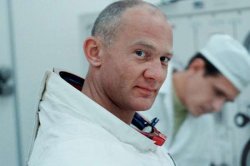
University Calendar
Buzz Aldrin and the Apollo 11 mission

Buzz Aldrin and the Apollo 11 mission
Roger Launius, author and former NASA Chief Historian.
Buzz Aldrin (1930- ) has become something of a punch line in recent years, despite being the second astronaut to set foot on the Moon in 1969. He has been a media hound for years, his much-publicized estrangement from his family, and his caricature in the recent film, First Man, have left his reputation in tatters. Some of this is appropriate; some not so much. This presentation will use the career of Buzz Aldrin to open the door on the role of the astronaut in reaching the Moon in the 1960s.
Aldrin made important contributions in spacewalking, understanding how to accomplish useful work while in zero gravity. Aldrin helped develop procedures to more effectively conduct useful work while weightless. His work on spacewalking, made it possible to depart the spacecraft and do something useful in the vacuum. Systematically and laboriously, Aldrin worked to develop procedures necessary to conduct spacewalks. He went into a large swimming pool to simulate the experience of zero gravity, with each step of the testing in the pool engineers modified the spacesuit to keep it from hindering movement by ballooning up and to keep it from either superheating or chilling the astronaut inside. Aldrin tested the new suit and the procedures developed for EVA during Gemini XII in November 1966 when he spent more than five hours outside the spacecraft and performed several functions necessary for the Moon landings.
Likewise, the rendezvous and docking of two spacecraft proved more difficult than envisioned. Holding a Ph.D. in astronautics from the Massachusetts Institute of Technology, astronaut Buzz Aldrin again played a significant role in developing the procedures to accomplish this in orbit. His MIT Ph.D. dissertation had offered the theoretical basis for orbital rendezvous and it provided the basis for the maneuvering and docking of two spacecraft in Earth orbit. Demonstration of this task proved successful only after many failures.
Speaker Biography:
Dr. Roger D. Launius is Principal of Launius Historical Services. Between 2002 and 2017 he worked in several positions at the Smithsonian Institution’s National Air and Space Museum in Washington, D.C., most recently as Associate Director for Collections and Curatorial Affairs. Between 1990 and 2002 he served as chief historian of the National Aeronautics and Space Administration. During at 35-year career as a U.S. government historian, he has been involved in many issues relating to public history and the history of aerospace technology. He has written or edited more than thirty books on aerospace history, most recently The Smithsonian History of Space Exploration: Discoveries from the Ancient World to the Extraterrestrial Future (Smithsonian Books, 2018), NASA Spaceflight: A History of Innovation (Palgrave Macmillan, 2018), and Historical Analogs for the Stimulation of Space Commerce (NASA, 2014). His forthcoming book, Apollo’s Legacy: The Moon Landings in Perspective (Smithsonian Books, 2019), focusing on the meaning of Apollo after fifty years. In addition, he is a Fellow of the American Association for the Advancement of Science, the International Academy of Astronautics, and the American Astronautical Society; and Associate Fellow of the American Institute for Aeronautics and Astronautics. He is frequently consulted by the electronic and print media for his views on space issues, and has been a guest commentator on National Public Radio and all the major television news networks.